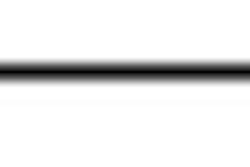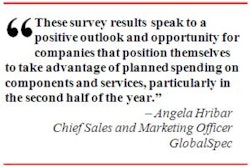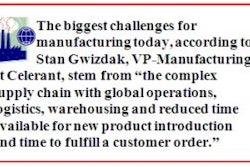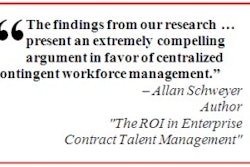
Arlington, VA — October 20, 2009 — The drip-drip-drip of less-bad news on the economy continued as the latest quarterly report from the Manufacturers Alliance/MAPI showed that while the economic recovery in manufacturing is likely to be marked with numerous rough patches, signs are finally emerging that the sector can expect brighter days ahead, including increasing backlogs and record-low inventories.
In the alliance's quarterly "Survey on the Business Outlook" for September 2009, a leading indicator for the industrial sector, the composite index rose to 38 from a near-historic low of 24 reported in the June 2009 report. It also represents the highest level in a year, since an index of 48 was recorded in September 2008.
At 38, however, the index still indicates that overall manufacturing activity is expected to contract over the next three to six months, relative to the levels of one year ago when the economy was entering the severe recession. MAPI also noted that the index measures the direction of change rather than the absolute strength of activity in manufacturing. The September 2009 index marks the fifth consecutive quarterly reading below 50, the demarcation point between growth and contraction.
Off of Record Lows
"The rise in the composite index and the individual indexes, most of which reached record lows in the first or second quarters of 2009, point to the start of a recovery in the manufacturing sector," said Donald A. Norman, MAPI Economist and survey coordinator. "While many of the individual indexes remain at very low levels, the forward-looking indexes, like that for annual orders, are at much higher levels, indicating that manufacturing activity is expected to increase in 2010."
A variety of individual indexes are included in the survey, and the business outlook index is a weighted sum of the shipments, backlogs, inventories and profit margin indexes.
As noted by Norman, there was some positive momentum in the group of forward-looking indexes. September is the quarter when executives are first asked about their expectations for the next calendar year in a number of areas. The annual orders index, based on a comparison of expected orders for all of 2010 with orders in 2009, was a strong 66 percent.
The non-U.S. investment index provides insight into expectations regarding capital expenditures abroad. The September 2009 index was 52 percent, with respondents anticipating marginally increased expenditures for capital spending outside the United States.
The U.S. investment index, which queried executives on their expectations regarding capital investment in 2010, was 47 percent, indicating slightly less domestic investment next year. The research and development (R&D) index asked respondents for their insights regarding R&D spending in 2010 compared to 2009. The R&D index was 49 percent, nearly equal to what companies will spend on R&D this year.
Mixed Messages
There were mixed messages in a number of indexes compared on a quarterly basis, according to MAPI, which said that while these indexes show some improvement, they still remain well under the 50 percent midpoint for growth.
The U.S. prospective shipments index, which reflects expectations for fourth quarter 2009 shipments compared with the fourth quarter of 2008, improved to 30 percent in the September survey compared to a miniscule 4 percent in the June report. Unfortunately, this implies that most companies will continue to see domestic shipments decrease this quarter compared to levels one year ago.
The non-U.S. prospective shipments index, which measures expectations for shipments abroad by foreign affiliates of U.S. firms in the fourth quarter of 2009 compared to the same quarter of 2008, rose to 33 percent from 15 percent. The export orders index, which measures how third quarter 2009 exports compare with those of third quarter 2008, increased to 19 percent in September from 11 percent in the June survey.
The quarterly orders index, which compared new orders for the third quarter of 2009 with the same quarter one year ago, edged up to 11 percent from 6 percent in the previous survey. Meanwhile, the backlogs index, which compared the third quarter 2009 backlog of orders with the backlog of orders one year earlier, rose to 16 percent from 9 percent in the June survey. An accumulation of backlogs usually occurs when new orders exceed shipments.
Inventories Hit Record Lows
The capacity utilization index, based on the percentage of firms operating above 85 percent of capacity, improved slightly, rising from 8.1 percent three months ago to 8.4 percent in the current survey. The profit margin index increased to 22 percent in September compared to 18 percent in the June report, snapping a string of seven straight quarters of decline.
The inventory index is based on a comparison of inventory levels in the third quarter of 2009 with those of one year ago. It dropped to a record low of 7 percent in September from 15 percent in June. This is a positive sign, MAPI said, in that it indicates manufacturers will need to increase production for restocking purposes and new orders.
A supplemental component of the survey asked how senior financial executives view the strength of the recovery. Most respondents, 72.9 percent, say business is improving, but that the recovery has been weak or that activity has merely stopped retracting. Two-thirds, 67.2 percent, expect sales to slowly improve over the next 12 months. The employment situation, however, may prove problematic: 70 percent have no plans to increase their workforce, 18.3 percent expect further reductions, and only 8.3 percent anticipate hiring new employees.
The survey reflects the views on current and future business conditions of 61 senior financial executives representing a broad range of manufacturing industries.
In the alliance's quarterly "Survey on the Business Outlook" for September 2009, a leading indicator for the industrial sector, the composite index rose to 38 from a near-historic low of 24 reported in the June 2009 report. It also represents the highest level in a year, since an index of 48 was recorded in September 2008.
At 38, however, the index still indicates that overall manufacturing activity is expected to contract over the next three to six months, relative to the levels of one year ago when the economy was entering the severe recession. MAPI also noted that the index measures the direction of change rather than the absolute strength of activity in manufacturing. The September 2009 index marks the fifth consecutive quarterly reading below 50, the demarcation point between growth and contraction.
Off of Record Lows
"The rise in the composite index and the individual indexes, most of which reached record lows in the first or second quarters of 2009, point to the start of a recovery in the manufacturing sector," said Donald A. Norman, MAPI Economist and survey coordinator. "While many of the individual indexes remain at very low levels, the forward-looking indexes, like that for annual orders, are at much higher levels, indicating that manufacturing activity is expected to increase in 2010."
A variety of individual indexes are included in the survey, and the business outlook index is a weighted sum of the shipments, backlogs, inventories and profit margin indexes.
As noted by Norman, there was some positive momentum in the group of forward-looking indexes. September is the quarter when executives are first asked about their expectations for the next calendar year in a number of areas. The annual orders index, based on a comparison of expected orders for all of 2010 with orders in 2009, was a strong 66 percent.
The non-U.S. investment index provides insight into expectations regarding capital expenditures abroad. The September 2009 index was 52 percent, with respondents anticipating marginally increased expenditures for capital spending outside the United States.
The U.S. investment index, which queried executives on their expectations regarding capital investment in 2010, was 47 percent, indicating slightly less domestic investment next year. The research and development (R&D) index asked respondents for their insights regarding R&D spending in 2010 compared to 2009. The R&D index was 49 percent, nearly equal to what companies will spend on R&D this year.
Mixed Messages
There were mixed messages in a number of indexes compared on a quarterly basis, according to MAPI, which said that while these indexes show some improvement, they still remain well under the 50 percent midpoint for growth.
The U.S. prospective shipments index, which reflects expectations for fourth quarter 2009 shipments compared with the fourth quarter of 2008, improved to 30 percent in the September survey compared to a miniscule 4 percent in the June report. Unfortunately, this implies that most companies will continue to see domestic shipments decrease this quarter compared to levels one year ago.
The non-U.S. prospective shipments index, which measures expectations for shipments abroad by foreign affiliates of U.S. firms in the fourth quarter of 2009 compared to the same quarter of 2008, rose to 33 percent from 15 percent. The export orders index, which measures how third quarter 2009 exports compare with those of third quarter 2008, increased to 19 percent in September from 11 percent in the June survey.
The quarterly orders index, which compared new orders for the third quarter of 2009 with the same quarter one year ago, edged up to 11 percent from 6 percent in the previous survey. Meanwhile, the backlogs index, which compared the third quarter 2009 backlog of orders with the backlog of orders one year earlier, rose to 16 percent from 9 percent in the June survey. An accumulation of backlogs usually occurs when new orders exceed shipments.
Inventories Hit Record Lows
The capacity utilization index, based on the percentage of firms operating above 85 percent of capacity, improved slightly, rising from 8.1 percent three months ago to 8.4 percent in the current survey. The profit margin index increased to 22 percent in September compared to 18 percent in the June report, snapping a string of seven straight quarters of decline.
The inventory index is based on a comparison of inventory levels in the third quarter of 2009 with those of one year ago. It dropped to a record low of 7 percent in September from 15 percent in June. This is a positive sign, MAPI said, in that it indicates manufacturers will need to increase production for restocking purposes and new orders.
A supplemental component of the survey asked how senior financial executives view the strength of the recovery. Most respondents, 72.9 percent, say business is improving, but that the recovery has been weak or that activity has merely stopped retracting. Two-thirds, 67.2 percent, expect sales to slowly improve over the next 12 months. The employment situation, however, may prove problematic: 70 percent have no plans to increase their workforce, 18.3 percent expect further reductions, and only 8.3 percent anticipate hiring new employees.
The survey reflects the views on current and future business conditions of 61 senior financial executives representing a broad range of manufacturing industries.











